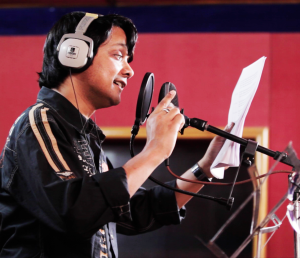By Sarah-Claire Jordan
 The film industry is probably one of the most influential industries based on a form of creative expression. With that expression, filmmakers are constantly conveying to their audiences a unique view of their own culture or an interpretation of another. However, it’s impossible to cross a lot of cultural boundaries when the film is in a language that the audience doesn’t understand. Subtitles are one option, but sometimes an audience prefers to hear a film rather than read it. The process of replacing the audio with translated audio is known as dubbing or “revoicing”.
The film industry is probably one of the most influential industries based on a form of creative expression. With that expression, filmmakers are constantly conveying to their audiences a unique view of their own culture or an interpretation of another. However, it’s impossible to cross a lot of cultural boundaries when the film is in a language that the audience doesn’t understand. Subtitles are one option, but sometimes an audience prefers to hear a film rather than read it. The process of replacing the audio with translated audio is known as dubbing or “revoicing”.
Before the actual dubbing can begin, the audio must be translated into the target language. This process is different from translating anything written, as there is a limited amount of time that the audio will actually be heard before the next bit starts. This is similar to creating translated subtitles, where literal translation is usually replaced with a translation that gets the basic meaning and intent of the original dialogue. With dubbing, however, the sounds of words have to match the shapes the actors are making with their mouths. This means changing out words that don’t have, say, an “o” sound for words that do when the actor’s mouth is creating an “o” sound shape. Add on the fact that the voice actors have to match the tone and rhythm of the original audio, and you’ve got yourself a lot of work ahead of you.
One method of , that is more commonly used for TV shows but has been used to for documentaries, is called UN-Style Voice Over. It takes its name from the international organization that typically uses this method when broadcasting meetings and other important events. At first, you hear the original speaker at a normal volume, but after a few seconds the volume drops and the translated audio starts. This is a good way to let the audience know what the tone and effect the original speaker uses and makes the actual production of the translated audio much simpler, since getting the tone, emotion, etc. to match is not as important.
The quintessential dubbing method is called Lip-Sync Dubbing, and is what you see in old kung fu movies. The basic idea is to take out the original audio completely, translate it, and then record it again, trying to get the mouth movements to match up. This isn’t always done very well, however, and we have much better technology now that can be used to make this better. The first technique is known as “looping” and consists of playing short pieces of the original dialogue over and over with a special machine until a suitable audio recording is done. Another less expensive way is Lock-to-Picture Recording, which is very similar except no fancy technology is needed. The voice actor just watches pieces of the film over and over and records their audio until it matches perfectly with the original performance.
Thanks to dubbing, people all over the world can enjoy the same movies and programs and aren’t limited to those made in their mother tongue.
For an overview of our translation expertise, visit our telephone interpreting service page



